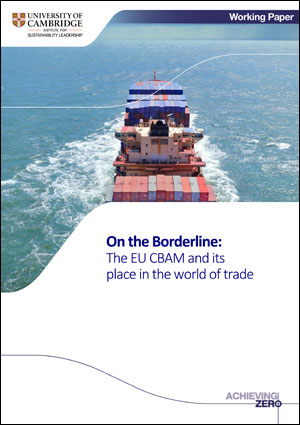October 2021 - The new CISL report ‘On the Borderline: the EU CBAM and its place in the world of trade’ shows unilateral action is risky but may be needed to achieve net zero by 2050.
Download the working paper
Watch the webinar.
About the working paper
A new independent review from CISL and Cambridge Econometrics outlines the strengths and weaknesses of carbon border adjustment mechanisms (CBAMs) in light of the EU’s proposal for a CBAM as part of the Fit for 55 Package published on 14 July 2021.
‘On the Borderline: The EU CBAM and its place in the world of trade’ examines the economic, environmental, legal and political dimensions of CBAMs. The report highlights the need for any future proposal to be carefully crafted to remain consistent with international trade law and to minimise risks of trade disputes and retaliation. The report concludes that an EU CBAM could form an important, and possibly necessary, part of the EU’s ambitions to reach net-zero emissions by 2050.
Key findings of the working paper
Economic, employment and environmental impacts
Macroeconomic modelling enabled several variations of an EU CBAM to be tested against a baseline case in which the EU achieves its emissions reduction targets without implementing a CBAM.
The findings suggest that the introduction of an EU CBAM could lead to a small increase in EU GDP, of 0.2 per cent by 2030 and 0.4 per cent by 2050, with potentially 600,000 additional jobs able to be created in the EU. It could also lead to a modest reduction in CO2 emissions outside the EU that can be interpreted as reduced carbon leakage.
Legal implications
The report explores the legal issues inherent in CBAMs where consistency in relation to international trade law has long been an issue of concern. A lack of precedent means that it remains unclear whether an EU CBAM would be considered fully legal if challenged. At least initially there would be substantial uncertainty about the long-term feasibility of the instrument. However, even if discovered to be in breach of trade rules, an EU CBAM could be subsequently brought into compliance. The main risk, therefore, is the triggering of retaliation and cross-retaliation, even before the matter is taken to litigation.
Political and diplomatic implications
The political and diplomatic implications of an EU CBAM would likely be complex, as many of the products covered in the scope of the current EU proposal have been the cause of global trade wars before. An EU CBAM can be expected to add further tension to the transatlantic relationship, as well as the strained relationships the EU has with Russia, China, Turkey and the UK.
Read the report for further details on the key findings across economic, employment and environmental impacts, legal implications and political and diplomatic implications.
Citing this report
Markkanen, S., Viñuales, J., Pollitt, H., Lee-Makiyama, H., Kiss-Dobronyi, B., Vaishnav, A. et al. (2021). On the Borderline: the EU CBAM and its place in the world of trade. Cambridge, UK: Cambridge Institute for Sustainability Leadership, University of Cambridge.
Eliot Whittington, Director of Policy, CISL said:
“Europe has a track record of global leadership on climate action but has consistently been concerned about the impact of its climate policies on key industries. Its new proposal for a Carbon Border Adjustment Mechanism takes this concern on squarely, in a way that should enable further action in Europe in response to the urgency of the climate challenge.
“However, unilateral action that affects EU trade relationships will be inevitably politically and legally fraught. As it explores this option the EU will need to balance the challenges of moving forward with this proposal against the lack of alternative options and the imperative of delivering of competitive, decarbonised economy.”
Hector Pollitt, Chief Economist, Cambridge Econometrics said:
“The analysis shows that a CBAM could be an important, and maybe necessary, part of Europe’s ambitions to meet its net-zero emission target, if other countries do not show similar levels of ambition. The CBAM could offer protection to EU industry, reduce carbon leakage and generate revenues for assisting in meeting broader climate goals.
"The macroeconomic impacts of a CBAM would be modest but there are larger benefits for the carbon-intensive, trade-exposed sectors that are directly impacted. However, a broad range of economic sectors could benefit overall from the introduction of a CBAM, depending on how the revenues generated by the CBAM are used.”
Professor Jorge E. Viñuales, Cambridge Centre for Environment, Energy and Natural Resource Governance (C-EENRG) said:
"It is widely understood that the legality of CBAMs is design-sensitive. From an international law perspective, the proposal is well crafted and could potentially pass scrutiny if challenged before a WTO panel. But some key aspects are still open, such as the treatment of free allowances, and others may be difficult to justify, such as imposing the EU carbon price extraterritorially. What it clearly shows is EU leadership in climate action."
The report was launched as part of a high-level event on 25 October. Learn more about the event here and access the recording here.
Read more thought leadership from CISL and the Centre for Policy and Industrial Transformation here.
Read more thought leadership from the Corporate Leaders Groups here.
Visit CLG Europe’s Fit for 55 Knowledge Hub to read more thought leadership on the Fit for 55 Package.




